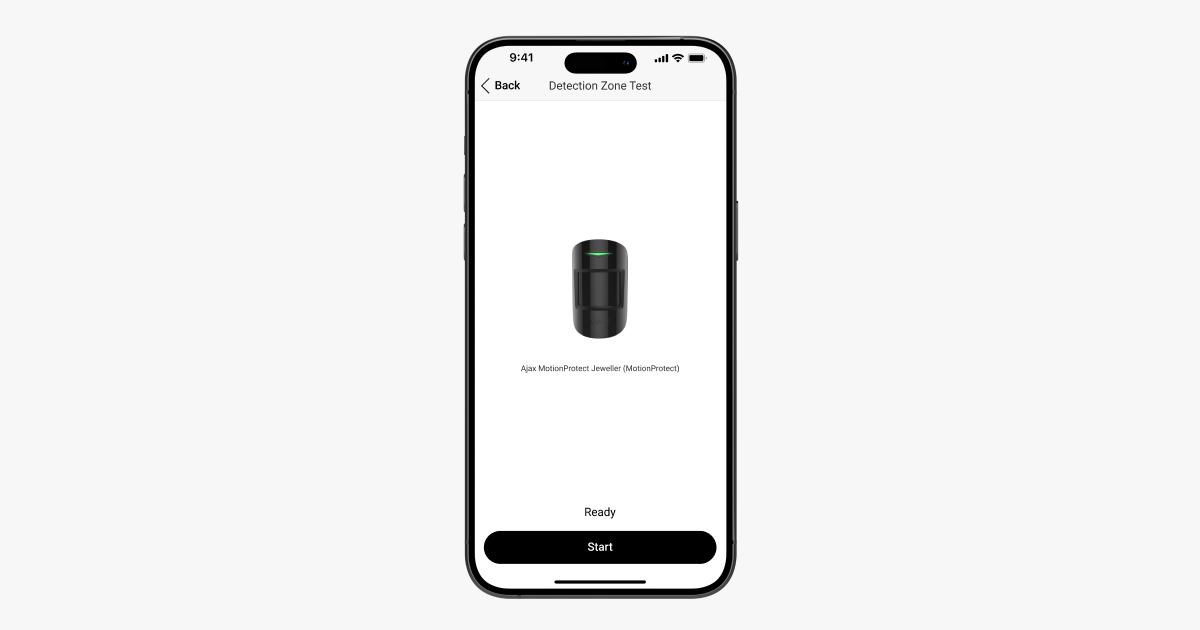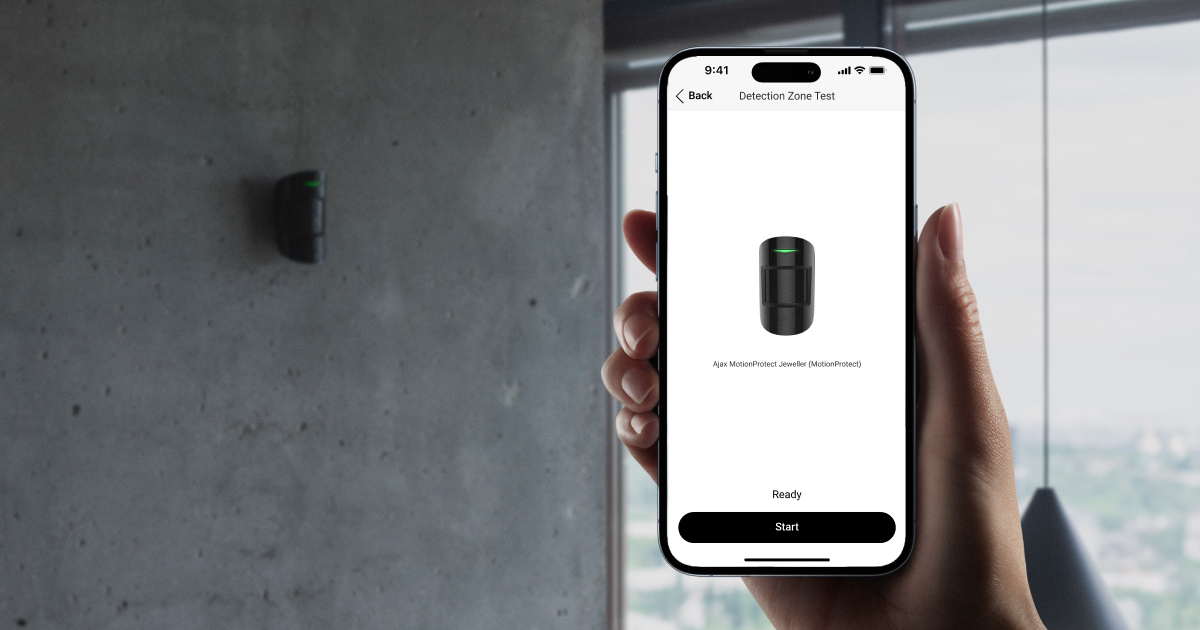O teste da zona de deteção permite-lhe determinar se o detetor responde adequadamente a um alarme no local de instalação selecionado. É possível efetuar o teste de duas formas:
- Aplicação Ajax → Dispositivos
→ Selecionar o dispositivo relevante → Definições
→ Teste da Zona de Deteção → Iniciar

- Aplicação Ajax → Dispositivos
→ Selecionar o hub → Definições
→ Teste da Zona de Deteção → Selecionar os dispositivos relevantes → Executar o teste para eles
Para determinar a área de deteção, consulte a indicação LED do dispositivo ou a notificação na app após o início do teste. Durante o teste, o indicador LED do dispositivo está constantemente ligado e desliga-se em caso de alarme. Ao mesmo tempo, aparece uma janela pop-up na app com informações sobre o dispositivo que foi acionado.
As notificações na app estão disponíveis para hubs com a versão de firmware Malevich 2.26 e posterior e em apps dessas versões e posteriores:
- Ajax Security System 3.11 para iOS;
- Ajax Security System 3.11 para Android;
- Ajax PRO: Tool for Engineers 2.11 para iOS;
- Ajax PRO: Tool for Engineers 2.11 para Android;
- Ajax PRO Desktop 4.11 para macOS;
- Ajax PRO Desktop 4.11 para Windows.
Se o tamper do dispositivo for acionado durante o teste da zona de deteção, o sistema notificará todos os utilizadores (notificações push nas apps Ajax e SMS) e a CRA.
| Dispositivo | Procedimento do teste |
|
Para verificar o detetor de abertura no local de instalação sugerido, abra e feche a porta/janela. Se o detetor responde a todas as ações, está instalado corretamente. Se o dispositivo com fios de terceiros estiver ligado ao contacto externo do detetor de abertura, cada dispositivo deve ser verificado separadamente. Por exemplo, verifique primeiro o detetor de abertura e depois o dispositivo ligado, |
|
|
Para verificar o detetor de movimento, atravesse a sala, seguindo a reação do LED, e determine a área de deteção do aparelho. A distância máxima de deteção de movimento é 12 metros. Se o detetor não responde sempre ao movimento durante o teste, deve ser montado noutro local. |
Contém testes do detetor de movimentos e de mascaramento dos sensores.
|
|
|
Para verificar o detetor no local de instalação previsto, atravesse a zona de deteção enquanto observa a reação do LED. Faça a mesma coisa, mas para direita e esquerda do detetor. Se o detetor não reage ao movimento conforme necessário, ajuste as suas definições em cada lado:
Para verificar os sensores de mascaramento, bloqueie a visão do detetor na zona de deteção com algum obstáculo de cada lado. Por exemplo, utilize uma folha de papel A4. Contacte o serviço de apoio Ajax se o detetor não responde aos obstáculos |
|
|
O detetor de quebra de vidros regista um alarme se detetar dois componentes: um componente de baixa frequência (som do impacto contra o vidro) e um componente de alta frequência (som de colisão de fragmentos de vidro um contra outro). Portanto, para verificar o detetor de quebra de vidro, bata com força numa superfície dura com o punho (preferencialmente no plano do vidro, mas sem quebrar). O detetor deve responder ao som de baixa frequência do impacto contra o vidro, desligando o LED durante 0,2 s. Se isto acontecer, lance um objeto metálico (por exemplo, uma colher) para a superfície dura ou bate-a com um copo de vidro num intervalo de um segundo e meio. O detetor apagará o LED durante um segundo; isto significa que, no modo armado, o detetor de quebra de vidros responderá normalmente à quebra do vidro. Diminua a sensibilidade do detetor e continue a verificar até que o detetor deixe de responder aos sons de alarme. Depois disso, o nível de sensibilidade deve voltar ao limite anterior, em que o detetor respondia normalmente. Desta forma, a probabilidade do detetor ser falsamente acionado é minimizada e, ao mesmo tempo, proporciona uma proteção fiável à instalação. Para garantir a máxima proteção contra falsos disparos, ligue todos os aparelhos que normalmente funcionam na sala: geradores, aparelhos de ar condicionado, etc. Se a ativação intermitente destes dispositivos provocará a ativação do detetor, o local de instalação deve ser escolhido com mais cuidado. Se o dispositivo com fios de terceiros estiver ligado ao contacto externo do detetor de quebra de vidros, cada dispositivo deve ser verificado separadamente. Por exemplo, verifique primeiro o detetor de quebra de vidros e depois o dispositivo ligado. |
|
|
Combina os procedimentos de teste MotionProtect e GlassProtect. Se o detetor responder de forma insatisfatória aos alarmes durante os testes, é necessário escolher outro local. |
